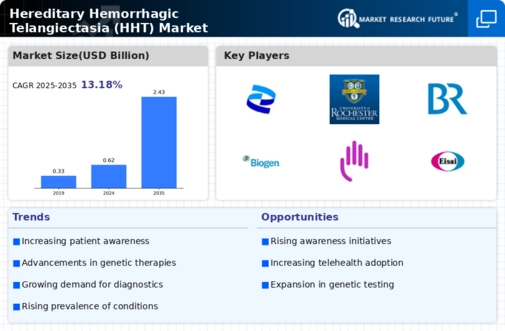Rising Prevalence of HHT
The increasing prevalence of Hereditary Hemorrhagic Telangiectasia (HHT) is a notable driver in the HHT Market. Recent estimates suggest that HHT affects approximately 1 in 5,000 individuals, indicating a substantial population that may require medical attention. This rising prevalence is likely to lead to heightened demand for diagnostic and therapeutic options, thereby expanding the market. As awareness grows, more individuals are being diagnosed, which could further contribute to market growth. The need for specialized care and management strategies for HHT patients is becoming increasingly recognized, prompting healthcare providers to focus on this condition. Consequently, the rising prevalence of HHT is expected to significantly influence the market dynamics, driving innovation and investment in treatment solutions.
Technological Innovations in Diagnostics
Technological advancements in diagnostic tools are transforming the landscape of the Hereditary Hemorrhagic Telangiectasia (HHT) Market. Innovations such as genetic testing and advanced imaging techniques are enhancing the accuracy of HHT diagnoses. These developments not only facilitate early detection but also improve patient outcomes by enabling timely interventions. The market for diagnostic tools is projected to grow as healthcare providers increasingly adopt these technologies. Furthermore, the integration of telemedicine and digital health solutions is likely to enhance patient access to specialized care, thereby expanding the market reach. As diagnostic capabilities improve, the overall management of HHT is expected to become more effective, which may lead to increased patient engagement and adherence to treatment protocols.
Regulatory Support for Treatment Approvals
Regulatory support for the approval of new treatments is a significant driver in the Hereditary Hemorrhagic Telangiectasia (HHT) Market. Regulatory agencies are increasingly recognizing the need for expedited pathways for therapies targeting rare diseases, including HHT. This supportive regulatory environment is likely to facilitate faster access to innovative treatments for patients. The potential for orphan drug designation and other incentives may encourage pharmaceutical companies to invest in HHT-related therapies. As a result, the market could witness a surge in the availability of effective treatment options, which may improve patient outcomes. The proactive stance of regulatory bodies in supporting the development of therapies for HHT is expected to be a key factor in shaping the future of the market.
Increased Patient Advocacy and Support Groups
The emergence of patient advocacy organizations and support groups is significantly influencing the Hereditary Hemorrhagic Telangiectasia (HHT) Market. These organizations play a vital role in raising awareness about HHT, educating patients and healthcare providers, and promoting research initiatives. By fostering a community of support, they empower patients to seek timely diagnosis and treatment. The activities of these groups are likely to enhance public understanding of HHT, which may lead to increased diagnosis rates and, consequently, a larger patient population seeking care. Furthermore, advocacy efforts can drive funding for research and development, thereby contributing to the advancement of treatment options. The growing presence of patient advocacy groups is expected to have a lasting impact on the market, as they continue to champion the needs of individuals affected by HHT.
Growing Investment in Research and Development
Investment in research and development (R&D) for Hereditary Hemorrhagic Telangiectasia (HHT) is a critical driver of the HHT Market. Pharmaceutical companies and research institutions are increasingly allocating resources to explore novel therapeutic approaches and improve existing treatments. This trend is underscored by the rising number of clinical trials focused on HHT, which indicates a robust pipeline of potential therapies. The financial commitment to R&D is likely to yield innovative solutions that address unmet medical needs within the HHT patient population. As new treatments emerge, they may enhance the quality of life for patients and potentially reshape the treatment landscape. The ongoing investment in R&D is expected to play a pivotal role in driving market growth and expanding therapeutic options for HHT.


















Leave a Comment